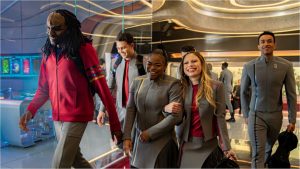
It is fair to say that Dan O’Bannon and Ronald Shusett’s original million-dollar idea for Alien remains one of the great all-time movie scares. A crew of astronauts, or at least space truckers, sits down for dinner before the long hyper-sleep home. Earlier in the story, one of them, a man, was attacked when an alien organism attached itself to his face. The crew’s science officer, a cagey and unknowable figure, tells us the man is fine. Yet come dinner time, everyone realizes too late that the man has been implanted (or impregnated) with extraterrestrial life. And it is a violent birth.
The visual of a creature bursting from a man’s chest remains one of the most viscerally disgusting moments in film history, and a scare so potent that even skeptical producer David Giler went from hating O’Bannon’s first draft to agreeing with Walter Hill that they needed to make this movie. For that brilliance alone, O’Bannon and Shusett’s contribution to cinema is immeasurable… and yet, year after year, the thing that most unsettles me about my frequent returns to the doomed voyage of the star freighter Nostromo is not the scene of a phallus with teeth bursting from John Hurt’s chest, nor is it the way O’Bannon’s Star Beast closes in on an outmatched and panicked Captain Dallas (Tom Skerritt).
No, the thing that gets under my skin like a facehugger’s grasping fingers is that science officer who should have seen the birth of “Kane’s son” coming… and in fact did. It’s the countenance of Ian Holm’s Ash and his seemingly benign smile, but cold eyes, that keeps me up at night. And curiously it was the producers and studio vets Giler and Hill who added this fateful android to the film.
“They took several cracks at drafts and they, from all consensuses, were getting worse and not better, because that wasn’t their forte,” story writer Shusett intriguingly asserted in a 2003 documentary about the making of Alien, The Beast Within. “They did recognize it was great, but they weren’t good at making it better or, in fact, not making it even worse. I am going to modify that with one exception… what they invented was the robot [who] was not in the movie…. that whole idea and scenario was theirs.”
It’s a pretty significant addition too. One which adds innumerable layers of menace and horror to the gloomy fates which awaited all of Ash’s fleshy co-workers.
As conceived by the film’s producers, and then brought to unnerving life by Holm, director Ridley Scott, and even Sigourney Weaver, who signaled so much unease and distrust with Ash through her performance, this synthetic android is just as potent an idea as the Star Beast who hibernates in your chest cavity. Plus, unlike the titular alien, the threat of Ash feels increasingly plausible as the years pass.
Much like John Hurt, who unsettled the Americans who missed the British thesp’s turn as Caligula on I, Claudius, Ian Holm was a relative unknown to U.S. audiences circa ’79. He was well regarded on the stage as a veteran of the Royal Shakespeare Company and even was a Tony winner in New York, but to the casual moviegoer unfamiliar with ITV programming and who had missed Jack Gold’s The Bofors Gun (1968), Holm was no more recognizable on the Nostromo than Sigourney Weaver was in her first lead role.
That works in Alien’s favor. With only Skerritt and Yaphet Kotto being mildly familiar character actors upon its release, there is no obvious hero in the film when the Nostromo’s crew is awakened from hyper-sleep by their spaceship’s deceptively nurturing automatic computer, Mother.
An obvious riff on HAL 9000 from Stanley Kubrick’s 2001: A Space Odyssey, Alien’s Mother is its own minor masterpiece in art direction courtesy of production designer Michael Seymour and conceptual artist Ron Cobb. All glowing celestial lights that cover a room floor to ceiling, and which is only accessed by the Nostromo’s captain (Dallas) and science officer (Ash), Mother resembles a virtual chapel. She offers a private sanctuary wherein the voice of god awaits. However, since viewers are conditioned to distrust any computer screen in a movie barely a decade out from 2001, the implicit foreboding one feels when Dallas relays Mother has “intercepted a transmission of unknown origin” is thick.
But Ash? He’s one of the crew, played with the same understated naturalism and camaraderie that’s provided by Skeritt, Kotto, Hurt, Harry Dean Stanton, or almost anyone else. Herein lies the true, insidious evil of Ash’s inclusion.
Ash is the definitive company stooge: a spy or mole implanted in the working class population to quietly sow division and guide his blue collar co-workers in whatever direction “the Company” wants—even if it’s to their literal doom. Consider again that scene where Dallas tells the other Nostromo working stiffs about Mother’s transmission. The lowest men on the totem pole, engineers Parker (Kotto) and Brett (Stanton), are unmoved by the thrill of possible scientific discovery.
“I hate to bring this up, but this is a commercial ship not a rescue ship,” Parker correctly points out. “It is not in my contract to do this kind of duty.”
It is Ash who immediately shuts down this earliest whiff of a conversation about the actual responsibilities or safety concerns of the crew. The science officer instead, rather quickly in retrospect, fires off: “There is a clause in the contract which specifically states any systematized transmission indicating a possible intelligent origin must be investigated…. on penalty of total forfeiture of shares. No money.”
It is the audience’s first hint of Ash’s true value to the Weyland-Yutani Corporation, which chartered the Nostromo’s mission. Despite allegedly being there as a veritable doctor responsible for the crew’s health, Ash is protecting the company’s bottom line by shutting down any free-thinking on the ship. Ash is even playing the class divisions of the crew off each other by implying Parker, the most junior in rank after Brett, is a greedy fool. Implicitly Ash is cultivating a power dynamic that encourages Dallas and the rest of the crew to look down on the most blue-collar members as lesser and unserious. He is pitting department heads against one another to divide and conquer.
This would set the tone of Ash’s role throughout the rest of Alien before the big reveal of his synthetic nature. When Weaver’s Ellen Ripley makes the smart and cautious decision of not letting Kane back onto the Nostromo after an alien organism has wrapped itself around his face—which turns out to be going by Weyland-Yutani’s own manual for safety precautions and against the panicked orders of Dallas who is trapped outside the ship with the infected Kane and Lambert (Veronica Cartwright)—it is Ash who disobeys protocol and the fact that when Dallas and Kane are offship, Ripley is the highest ranking officer aboard. Ash lets Kane in, breaking quarantine.
In the subsequent scene, Ripley icily points out that Ash disobeyed the rulebook, but the robot who revealed an encyclopedic knowledge of their contract earlier feigns ignorance to Ripley. But then Ash pretends to be ignorant about a lot of things during the movie, including by seeming totally oblivious to the alien creature growing in Kane’s body in spite of taking x-ray scans.
This is of course because unlike 2001’s HAL 9000, Ash works mostly the way Weyland-Yutani programmed him to. He is a robot pretending to be a man while actively undermining the crew. As Mother even eventually reveals to Ripley after all hell has broken loose and most of the crew is dead, “Priority One: Insure return of organism for analysis. All other considerations secondary. Crew expendable.”
Ash follows the new orders to the letter—yet how he does it is where the floor falls out, and the full depth of Alien’s insidiousness becomes bottomless.
Throughout the movie, Ash follows the command to protect the alien organism at the expense of the crew, including even preventing Parker from attacking the creature after it bursts from Kane’s chest and is still small and relatively vulnerable. But the way Ash carries out these actions is what rewards repeat viewings. As with the mystery of the Space Jockey and derelict alien vessel the crew discovers on LV-426, the entire backstory of Ash’s orders or intentions remain elusive and ultimately ambiguous.
While Holm instills Ash with an awkward and seemingly stilted sociability, suggesting perhaps an introvert who is hapless in interpersonal interactions, there is a callousness in his smile that only Weaver’s Ripley seems to notice. Before we even see Ash work quietly against the crew, Ellen asks Dallas about whether he’s worked with their new science officer before. Similarly, well ahead of the famous chest-burst scene, when Ripley admonishes Ash for insubordination and breaking the chain of command, there is a cruel almost reptilian animosity in his stare toward Ripley. Despite being a robot programmed to protect an alien organism, Ash seems to retain real human emotions of animosity and loathing toward a woman asserting authority over him.
Is this a feint, similar to Ash’s smile, or an actual sentient reaction? Why does Ash act as if he is cold and run in place to warm himself up on the Nostromo bridge when no one else is watching? The actual sentiency and thought process of the robot is unknowable, and yet the apparent misogyny and toxicity of the character is not.
In the famous scene where Ripley realizes Mother and Ash have decided her life is forfeit, Ash attempts to not only silence Ripley from warning Parker and Lambert, but attempts to kill her by shoving a pornographic magazine down her throat until she chokes to death.
During the Beast Within documentary, Ridley Scott said about the scene he developed and directed: “I always thought that was interesting. Do androids have sexual urges? This is the closest he gets to a sexual relationship.” In Scott’s mind, Ash forcing a magazine other male crew members are likely using for masturbation into Ripley’s mouth is an act of sexual penetration and violation. It is the film’s second rape scene after the facehugger slid its orifice down Kane’s throat.
The horror and evil of the sequence also raises a litany of other questions. Was Ash programmed to want to violate, humiliate, or attack the women on the ship? Or do his actions reflect the unconscious biases of his makers?
In effect, Ash raises the questions we are currently having about artificial intelligence today. While the AI currently being developed and deified in Silicon Valley is ostensibly controlled and divorced from human prejudices and bigotries, the selection criteria AI’s input-based models sift through are inherently influenced by the biases and perspectives of those who create them. It’s how we end up with law enforcement software that predicts Black men are more likely to become repeat offenders of crimes over white men convicted of the same charges.
These disquieting questions and implications are all there in Ash: a robot designed to look like a man in order to manipulate and control actual human beings… and in that act of infiltration is somehow designed to hate and assault women.
Holm communicates these contradictions and mysteries by firmly placing his characterization of Ash in the uncanny valley. It’s impossible to gauge whether it is for his benefit or no one’s when Ash seems to keep himself warm with movement and exercise, or whether he actually finds Parker and Kane’s banter at the dinner table funny. Yet much like the actual real-world implications of AI today, he is being used to divide, devalue, and ultimately destroy working class lives. To what ends only the synthetic engineers and C-suite executives at Weyland-Yutani would know for sure. We don’t even understand if the Nostromo and Ash were the first freighter sent on the suicide mission to LV-426.
The mystery of Ash is just as potent as the eponymous Alien’s originally impenetrable life-cycle and intentions. And unlike that gooey xenomorph, Ash’s full designs and aspirations were never diluted by sequels that filled in the blanks. He’s a milky nightmare whose actions remain open to endless interpretation.
The post Ian Holm’s Ash is the Scariest Monster in Alien appeared first on Den of Geek.





